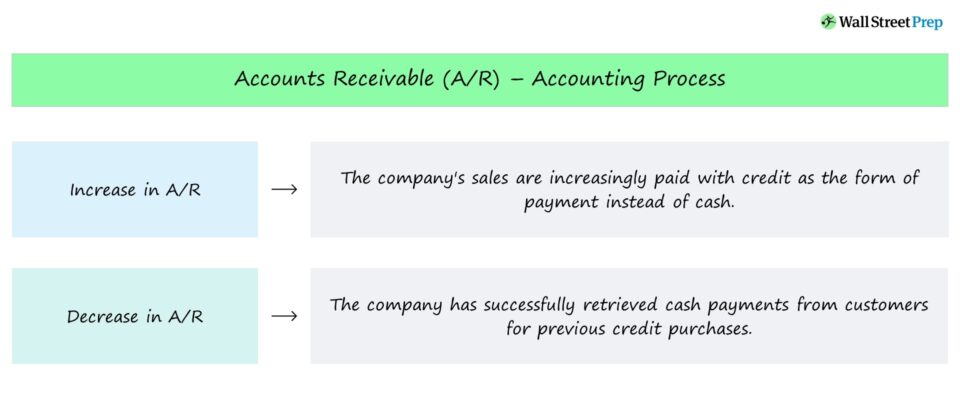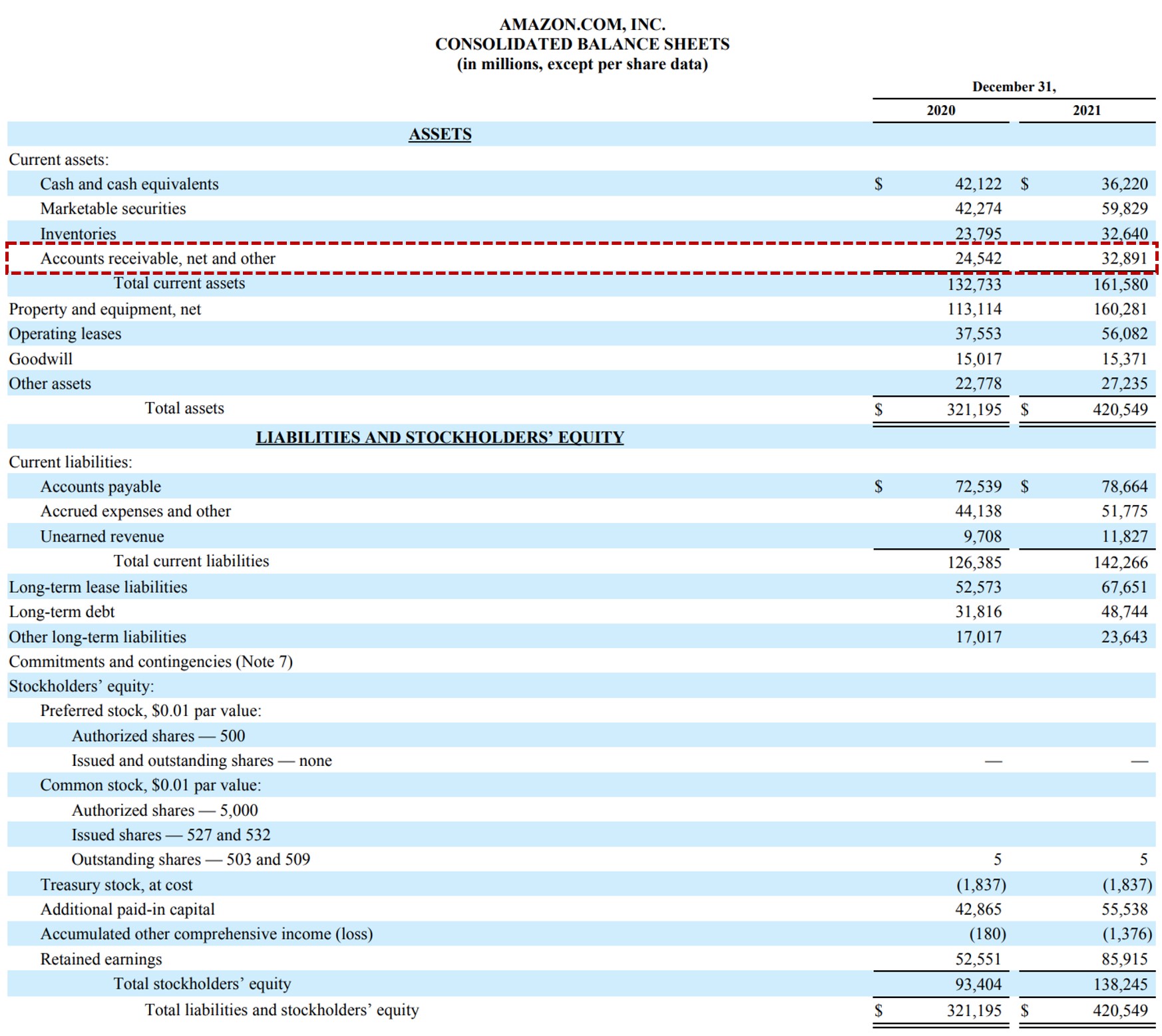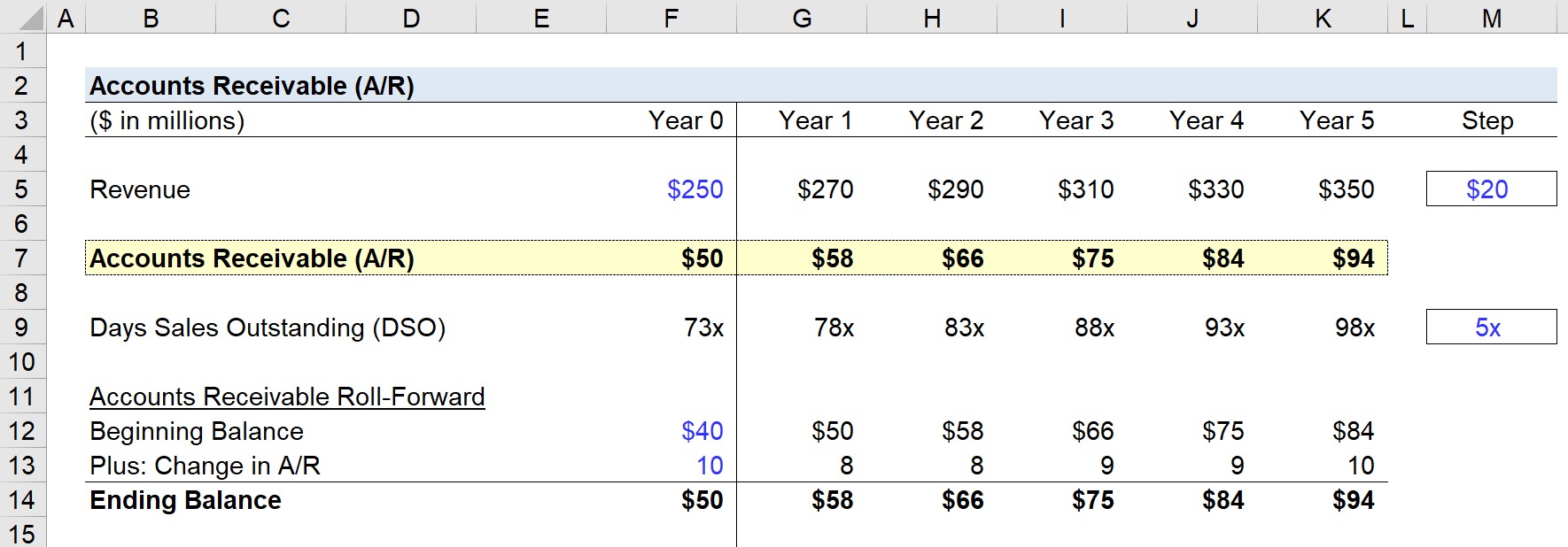- What is Accounts Receivable?
- How are Accounts Receivable Created?
- Accounts Receivable Formula
- What is a Good Accounts Receivable?
- Accounts Receivable vs. Accounts Payable: What is the Difference?
- Accounts Receivable Example
- What is the Journal Entry for Accounts Receivable?
- How to Find Accounts Receivable on Balance Sheet
- Accounts Receivable Calculator
- 1. Days Sales Outstanding Calculation (DSO)
- 2. Accounts Receivable Calculation Example
What is Accounts Receivable?
Accounts Receivable (A/R) is defined as payments owed to a company by its customers for products and/or services already delivered to them – i.e. an “IOU” from customers who paid on credit.

How are Accounts Receivable Created?
Under accrual accounting, the accounts receivable line item, often abbreviated as “A/R”, refers to payments not yet received by customers that paid using credit rather than cash.
Conceptually, accounts receivable reflects a company’s total outstanding (or unpaid) customer invoices.
Given the fact that the customer has not yet paid the company, the question here is, “Is accounts receivable an asset or a liability?”
Since the unmet payment obligation represents a future economic benefit to the company, the accounts receivables line item is categorized as a current asset on the balance sheet.
Why? The company anticipates receiving the owed payment in cash soon (“cash inflow”).
However, as part of the revenue recognition policy established under accrual accounting standards, the amount charged to the customer is recognized as revenue once the customer is billed, irrespective of the fact that the cash still remains under the possession of the customer.
Whether cash payment was received or not, revenue is still recognized on the income statement and the amount to be paid by the customer can be found on the accounts receivable line item.
Accounts Receivable Formula
For purposes of forecasting accounts receivable in a financial model, the standard modeling convention is to tie A/R to revenue, since the relationship between the two is closely intertwined.
In practice, projecting the accounts receivable balance of a company is most often performed via the days sales outstanding (DSO) metric.
The days sales outstanding (DSO) measures the number of days on average it takes for a company to collect cash from customers that paid on credit.
The formula to calculate days sales outstanding (DSO) is equal to the average accounts receivable divided by revenue, and then multiplied by 365 days.
Note, the ending accounts receivable balance can be used, rather than the average balance, assuming the historical trend is consistent with minimal fluctuations.
To properly forecast A/R, following the historical patterns and analyzing the trend in DSO across the past couple of years is recommended.
Or, in a much simpler approach, rely on the average if there appears to be no significant shifts (i.e. only minor fluctuations).
- Rising Days Sales Outstanding (DSO) ➝ If the days sales outstanding (DSO) of a company have been increasing over time, that implies the company’s collection efforts require improvement, as more A/R means more cash is tied up in operations.
- Declining Days Sales Outstanding (DSO) ➝ But if a company’s days sales outstanding (DSO) declines, that implies the company’s collection efforts are improving, which has a positive impact on the cash flows of the company.
The pro forma accounts receivable (A/R) balance can be determined by rearranging the formula from earlier.
The forecasted accounts receivable balance is equal to the days sales outstanding (DSO) assumption divided by 365 days, multiplied by 365 days.
What is a Good Accounts Receivable?
If a company’s accounts receivable balance increases, more revenue must have been earned with payment in the form of credit, so more cash payments must be collected in the future.
On the other hand, if a company’s A/R balance declines, the invoices billed to customers that paid on credit were completed and the money was received in cash.
To reiterate, the relationship between accounts receivable and free cash flow (FCF) is as follows:
- Increase in Accounts Receivable (A/R) ➝ The company’s sales are increasingly paid with credit as the form of payment instead of cash.
- Decrease in Accounts Receivable (A/R) ➝ The company has successfully retrieved cash payments for credit purchases.
With that said, an increase in accounts receivable represents a reduction in cash on the cash flow statement, whereas a decrease reflects an increase in cash.
On the cash flow statement (CFS), the starting line item is net income, which is then adjusted for non-cash add-backs and changes in working capital in the cash from operations (CFO) section.
Since an increase in A/R signifies that more customers paid on credit during the given period, it is shown as a cash outflow (i.e. “use” of cash) – which causes a company’s ending cash balance and free cash flow (FCF) to decline.
While the revenue has technically been earned under accrual accounting, the customers have delayed paying in cash, so the amount sits as accounts receivables on the balance sheet.
Accounts Receivable vs. Accounts Payable: What is the Difference?
The difference between accounts receivable and accounts payable is as follows.
- Accounts Receivable (A/R) ➝ Accounts receivable is a current asset recorded on the balance sheet that captures the outstanding cash payments still owed from customers, i.e. the money owed from customers that paid using credit.
- Accounts Payable (A/P) ➝ In contrast, accounts payable is a current liability recognized on the balance sheet that reflects the cash payments that the company owes to suppliers and vendors, i.e. the company paid using credit as the form of payment.
Accounts Receivable Example
Suppose an electronic components supplier received an order from a manufacturer. The manufacturer placed an order and the requested components were delivered based on the purchase agreement.
Therefore, the supplier sent the customer, i.e. the manufacturer, an invoice for the amount owed, which we’ll assume to be $50k.
However, the manufacturer is a long-time customer with an agreement that provides them with 60 days to pay post-receipt of the invoice.
In the 60-day period, the $50k that the manufacturer still owes is recorded as accounts receivable on the books because the outstanding invoice represents an unmet obligation, in which the customer has not yet paid for the goods that were delivered.
On the income statement, the $50k is recognized as revenue per accrual accounting policies but recorded as accounts receivable too since the payment has not yet been received.
Until the manufacturer issues the payment to complete the invoice, the accounts receivable remains on the balance sheet.
What is the Journal Entry for Accounts Receivable?
Using the same assumptions as the prior section, the journal entry to reflect the purchase made on credit is as follows.
Credit Sale
- Debit (DR) ➝ Accounts Receivable Account = $50k
- Credit (CR) ➝ Revenue Account = $50k
The journal entry reflects that the supplier recognized the transaction as revenue because the product was delivered, but is waiting to receive the cash payment. Hence, the debit to the accounts receivable account, i.e. the manufacturer owes money to the supplier.
Cash Payment
- Debit (DR) ➝ Cash Account = $50k
- Credit (CR) ➝ Accounts Receivable = $50k
The adjusting journal entry here reflects that the supplier received the payment in cash.
The debit to the cash account causes the supplier’s cash on hand to increase, whereas the credit to the accounts receivable account reduces the amount still owed.
How to Find Accounts Receivable on Balance Sheet
The screenshot below is from the latest 10-K filing by Amazon (AMZN) for the fiscal year ending 2021.
Amazon.com, Inc. 10-K Filing, 2022 (Source: AMZN 10-K)
Accounts Receivable Calculator
We’ll now move to a modeling exercise, which you can access by filling out the form below.
1. Days Sales Outstanding Calculation (DSO)
In our illustrative example, we’ll assume we have a company with $250 million in revenue in Year 0.
At the beginning of Year 0, the accounts receivable balance is $40 million but the change in A/R is assumed to be an increase of $10 million, so the ending A/R balance is $50 million in Year 0.
Financial Data (Year 0)
- Beginning Accounts Receivable (A/R) = $40 million
- Change in A/R = +$10 million
- Ending Accounts Receivable (A/R) = $40 million + $10 million = $50 million
For Year 0, we can calculate the days sales outstanding (DSO) with the following formula:
- Days Sales Outstanding (DSO), Year 0 = ($50 million ÷ $250 million) × 365 Days = 73 Days
2. Accounts Receivable Calculation Example
As for the projection period from Year 1 to Year 5, the following assumptions will be used:
- Revenue, Step Function ➝ Increase by +$20m per Year
- Days Sales Outstanding (DSO), Step Function ➝ Increase by +$5m per Year
The assumptions are extended (i.e. “straight-lined”) across the entire forecast, until a revenue balance of $350 million is reached by the end of Year 5.
By the end of Year 5, the company’s accounts receivable balance expanded to $94 million, based on the days sales outstanding (DSO) assumption of 98 days.
Starting from Year 0, the accounts receivable balance grew from $50 million to $94 million in Year 5, as captured in our roll-forward.
The change in A/R is represented on the cash flow statement (CFS), where the ending balance in the accounts receivable roll-forward schedule flows in as the ending balance on the balance sheet, as of the current period.
The net cash impact is negative since the days sales outstanding (DSO) is increasing each period.
The company must identify the source of the rising accounts receivable balance (e.g. collection issues) and adjust accordingly if deemed necessary.

Everything You Need To Master Financial Modeling
Enroll in The Premium Package: Learn Financial Statement Modeling, DCF, M&A, LBO and Comps. The same training program used at top investment banks.
Enroll Today








What does it mean if receivables are in negative and increasing.
I mean more negative.
From -100 to -200.